Intercultural Business Communication: Strategies and Challenges
VerifiedAdded on 2023/06/10
|7
|2534
|275
AI Summary
This report provides a detailed information that is being used to influence cross-cultural communication in international teamwork. It discusses the behavior of participants as defined in the scenario and the main problem in intercultural business communication along with the use of specified frameworks for defining the intercultural business communication. The report mainly uses the understanding of the Hofstede’s framework for the better understanding of the attitudes and behaviours of the participants in the given case study. At the end of the report, a conclusion has been provided, which summarizes the overall understanding of the report to provide an overview to the reader.
Contribute Materials
Your contribution can guide someone’s learning journey. Share your
documents today.

Running head: INTERCULTURAL BUSINESS COMMUNICATION
intercultural business communication
intercultural business communication
Secure Best Marks with AI Grader
Need help grading? Try our AI Grader for instant feedback on your assignments.
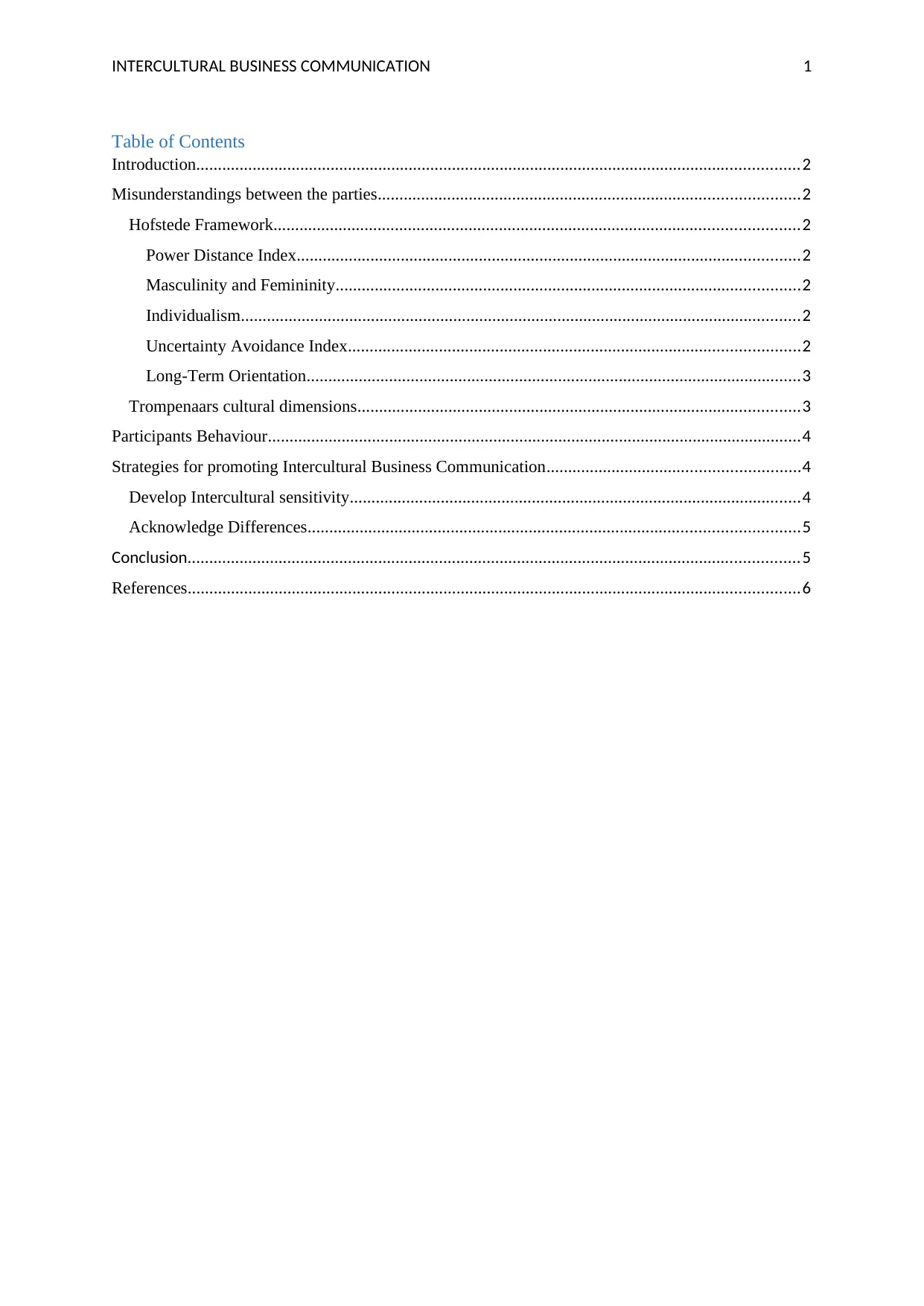
INTERCULTURAL BUSINESS COMMUNICATION 1
Table of Contents
Introduction...........................................................................................................................................2
Misunderstandings between the parties.................................................................................................2
Hofstede Framework.........................................................................................................................2
Power Distance Index....................................................................................................................2
Masculinity and Femininity...........................................................................................................2
Individualism.................................................................................................................................2
Uncertainty Avoidance Index........................................................................................................2
Long-Term Orientation..................................................................................................................3
Trompenaars cultural dimensions......................................................................................................3
Participants Behaviour...........................................................................................................................4
Strategies for promoting Intercultural Business Communication..........................................................4
Develop Intercultural sensitivity........................................................................................................4
Acknowledge Differences.................................................................................................................5
Conclusion.............................................................................................................................................5
References.............................................................................................................................................6
Table of Contents
Introduction...........................................................................................................................................2
Misunderstandings between the parties.................................................................................................2
Hofstede Framework.........................................................................................................................2
Power Distance Index....................................................................................................................2
Masculinity and Femininity...........................................................................................................2
Individualism.................................................................................................................................2
Uncertainty Avoidance Index........................................................................................................2
Long-Term Orientation..................................................................................................................3
Trompenaars cultural dimensions......................................................................................................3
Participants Behaviour...........................................................................................................................4
Strategies for promoting Intercultural Business Communication..........................................................4
Develop Intercultural sensitivity........................................................................................................4
Acknowledge Differences.................................................................................................................5
Conclusion.............................................................................................................................................5
References.............................................................................................................................................6
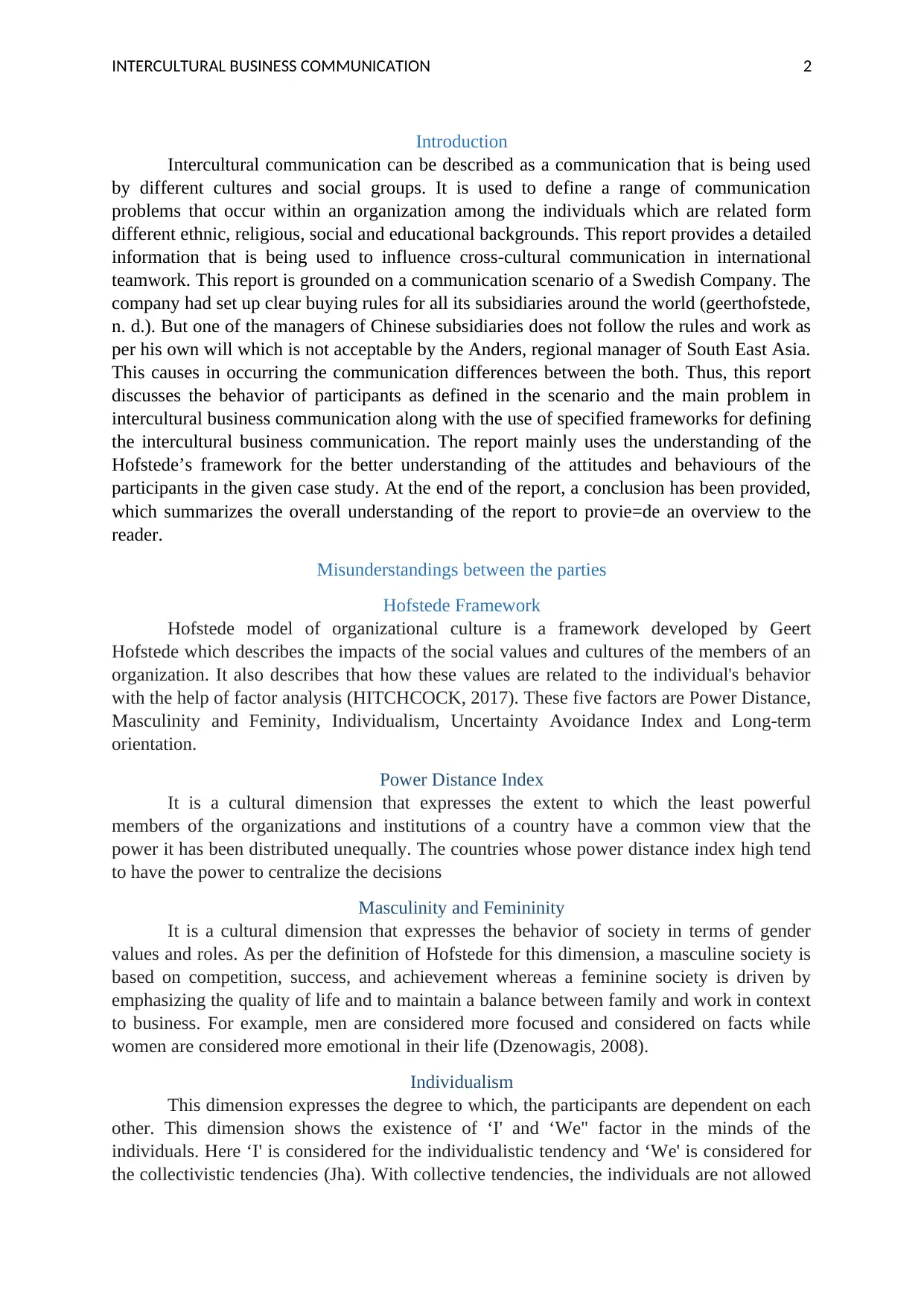
INTERCULTURAL BUSINESS COMMUNICATION 2
Introduction
Intercultural communication can be described as a communication that is being used
by different cultures and social groups. It is used to define a range of communication
problems that occur within an organization among the individuals which are related form
different ethnic, religious, social and educational backgrounds. This report provides a detailed
information that is being used to influence cross-cultural communication in international
teamwork. This report is grounded on a communication scenario of a Swedish Company. The
company had set up clear buying rules for all its subsidiaries around the world (geerthofstede,
n. d.). But one of the managers of Chinese subsidiaries does not follow the rules and work as
per his own will which is not acceptable by the Anders, regional manager of South East Asia.
This causes in occurring the communication differences between the both. Thus, this report
discusses the behavior of participants as defined in the scenario and the main problem in
intercultural business communication along with the use of specified frameworks for defining
the intercultural business communication. The report mainly uses the understanding of the
Hofstede’s framework for the better understanding of the attitudes and behaviours of the
participants in the given case study. At the end of the report, a conclusion has been provided,
which summarizes the overall understanding of the report to provie=de an overview to the
reader.
Misunderstandings between the parties
Hofstede Framework
Hofstede model of organizational culture is a framework developed by Geert
Hofstede which describes the impacts of the social values and cultures of the members of an
organization. It also describes that how these values are related to the individual's behavior
with the help of factor analysis (HITCHCOCK, 2017). These five factors are Power Distance,
Masculinity and Feminity, Individualism, Uncertainty Avoidance Index and Long-term
orientation.
Power Distance Index
It is a cultural dimension that expresses the extent to which the least powerful
members of the organizations and institutions of a country have a common view that the
power it has been distributed unequally. The countries whose power distance index high tend
to have the power to centralize the decisions
Masculinity and Femininity
It is a cultural dimension that expresses the behavior of society in terms of gender
values and roles. As per the definition of Hofstede for this dimension, a masculine society is
based on competition, success, and achievement whereas a feminine society is driven by
emphasizing the quality of life and to maintain a balance between family and work in context
to business. For example, men are considered more focused and considered on facts while
women are considered more emotional in their life (Dzenowagis, 2008).
Individualism
This dimension expresses the degree to which, the participants are dependent on each
other. This dimension shows the existence of ‘I' and ‘We" factor in the minds of the
individuals. Here ‘I' is considered for the individualistic tendency and ‘We' is considered for
the collectivistic tendencies (Jha). With collective tendencies, the individuals are not allowed
Introduction
Intercultural communication can be described as a communication that is being used
by different cultures and social groups. It is used to define a range of communication
problems that occur within an organization among the individuals which are related form
different ethnic, religious, social and educational backgrounds. This report provides a detailed
information that is being used to influence cross-cultural communication in international
teamwork. This report is grounded on a communication scenario of a Swedish Company. The
company had set up clear buying rules for all its subsidiaries around the world (geerthofstede,
n. d.). But one of the managers of Chinese subsidiaries does not follow the rules and work as
per his own will which is not acceptable by the Anders, regional manager of South East Asia.
This causes in occurring the communication differences between the both. Thus, this report
discusses the behavior of participants as defined in the scenario and the main problem in
intercultural business communication along with the use of specified frameworks for defining
the intercultural business communication. The report mainly uses the understanding of the
Hofstede’s framework for the better understanding of the attitudes and behaviours of the
participants in the given case study. At the end of the report, a conclusion has been provided,
which summarizes the overall understanding of the report to provie=de an overview to the
reader.
Misunderstandings between the parties
Hofstede Framework
Hofstede model of organizational culture is a framework developed by Geert
Hofstede which describes the impacts of the social values and cultures of the members of an
organization. It also describes that how these values are related to the individual's behavior
with the help of factor analysis (HITCHCOCK, 2017). These five factors are Power Distance,
Masculinity and Feminity, Individualism, Uncertainty Avoidance Index and Long-term
orientation.
Power Distance Index
It is a cultural dimension that expresses the extent to which the least powerful
members of the organizations and institutions of a country have a common view that the
power it has been distributed unequally. The countries whose power distance index high tend
to have the power to centralize the decisions
Masculinity and Femininity
It is a cultural dimension that expresses the behavior of society in terms of gender
values and roles. As per the definition of Hofstede for this dimension, a masculine society is
based on competition, success, and achievement whereas a feminine society is driven by
emphasizing the quality of life and to maintain a balance between family and work in context
to business. For example, men are considered more focused and considered on facts while
women are considered more emotional in their life (Dzenowagis, 2008).
Individualism
This dimension expresses the degree to which, the participants are dependent on each
other. This dimension shows the existence of ‘I' and ‘We" factor in the minds of the
individuals. Here ‘I' is considered for the individualistic tendency and ‘We' is considered for
the collectivistic tendencies (Jha). With collective tendencies, the individuals are not allowed
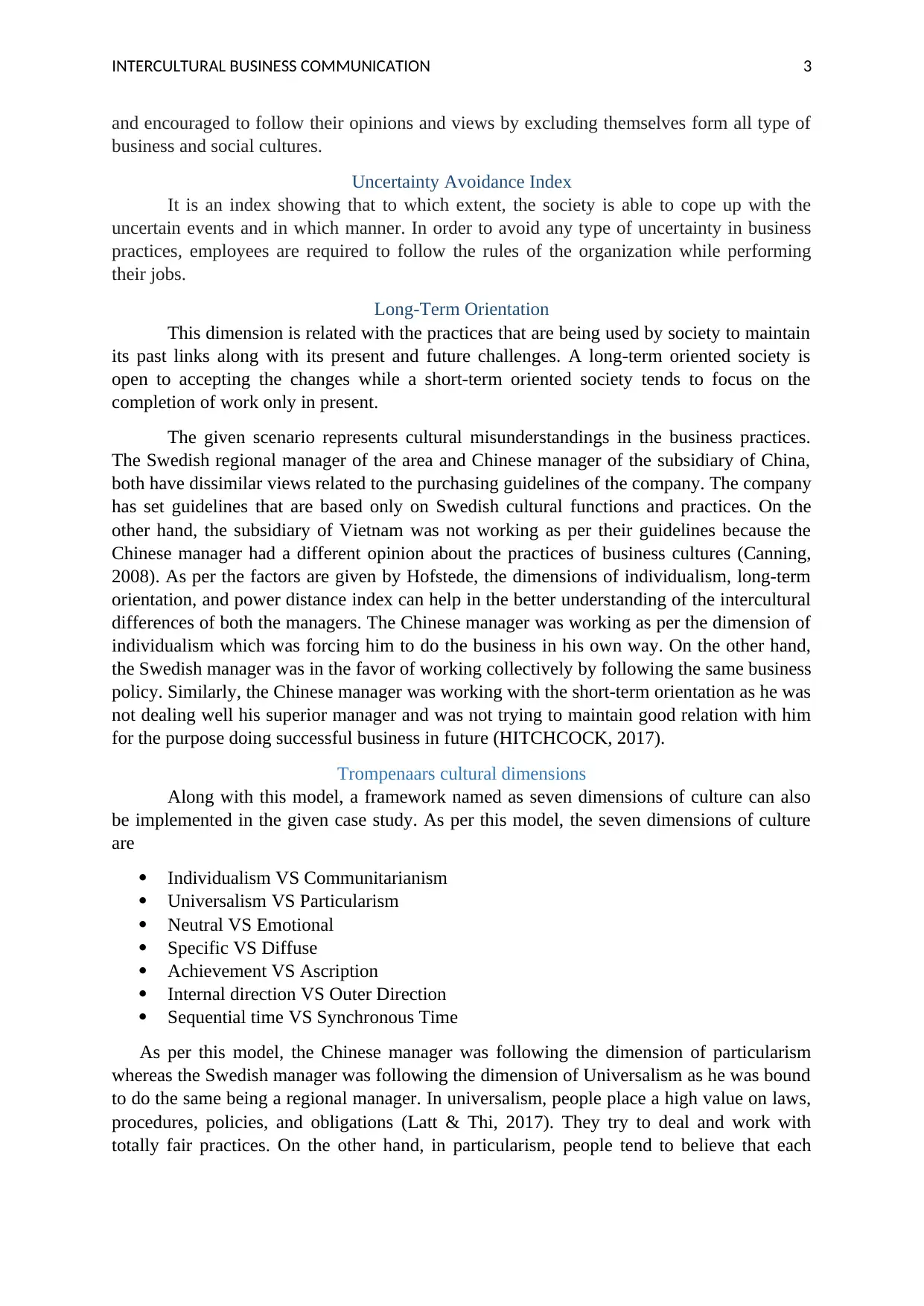
INTERCULTURAL BUSINESS COMMUNICATION 3
and encouraged to follow their opinions and views by excluding themselves form all type of
business and social cultures.
Uncertainty Avoidance Index
It is an index showing that to which extent, the society is able to cope up with the
uncertain events and in which manner. In order to avoid any type of uncertainty in business
practices, employees are required to follow the rules of the organization while performing
their jobs.
Long-Term Orientation
This dimension is related with the practices that are being used by society to maintain
its past links along with its present and future challenges. A long-term oriented society is
open to accepting the changes while a short-term oriented society tends to focus on the
completion of work only in present.
The given scenario represents cultural misunderstandings in the business practices.
The Swedish regional manager of the area and Chinese manager of the subsidiary of China,
both have dissimilar views related to the purchasing guidelines of the company. The company
has set guidelines that are based only on Swedish cultural functions and practices. On the
other hand, the subsidiary of Vietnam was not working as per their guidelines because the
Chinese manager had a different opinion about the practices of business cultures (Canning,
2008). As per the factors are given by Hofstede, the dimensions of individualism, long-term
orientation, and power distance index can help in the better understanding of the intercultural
differences of both the managers. The Chinese manager was working as per the dimension of
individualism which was forcing him to do the business in his own way. On the other hand,
the Swedish manager was in the favor of working collectively by following the same business
policy. Similarly, the Chinese manager was working with the short-term orientation as he was
not dealing well his superior manager and was not trying to maintain good relation with him
for the purpose doing successful business in future (HITCHCOCK, 2017).
Trompenaars cultural dimensions
Along with this model, a framework named as seven dimensions of culture can also
be implemented in the given case study. As per this model, the seven dimensions of culture
are
Individualism VS Communitarianism
Universalism VS Particularism
Neutral VS Emotional
Specific VS Diffuse
Achievement VS Ascription
Internal direction VS Outer Direction
Sequential time VS Synchronous Time
As per this model, the Chinese manager was following the dimension of particularism
whereas the Swedish manager was following the dimension of Universalism as he was bound
to do the same being a regional manager. In universalism, people place a high value on laws,
procedures, policies, and obligations (Latt & Thi, 2017). They try to deal and work with
totally fair practices. On the other hand, in particularism, people tend to believe that each
and encouraged to follow their opinions and views by excluding themselves form all type of
business and social cultures.
Uncertainty Avoidance Index
It is an index showing that to which extent, the society is able to cope up with the
uncertain events and in which manner. In order to avoid any type of uncertainty in business
practices, employees are required to follow the rules of the organization while performing
their jobs.
Long-Term Orientation
This dimension is related with the practices that are being used by society to maintain
its past links along with its present and future challenges. A long-term oriented society is
open to accepting the changes while a short-term oriented society tends to focus on the
completion of work only in present.
The given scenario represents cultural misunderstandings in the business practices.
The Swedish regional manager of the area and Chinese manager of the subsidiary of China,
both have dissimilar views related to the purchasing guidelines of the company. The company
has set guidelines that are based only on Swedish cultural functions and practices. On the
other hand, the subsidiary of Vietnam was not working as per their guidelines because the
Chinese manager had a different opinion about the practices of business cultures (Canning,
2008). As per the factors are given by Hofstede, the dimensions of individualism, long-term
orientation, and power distance index can help in the better understanding of the intercultural
differences of both the managers. The Chinese manager was working as per the dimension of
individualism which was forcing him to do the business in his own way. On the other hand,
the Swedish manager was in the favor of working collectively by following the same business
policy. Similarly, the Chinese manager was working with the short-term orientation as he was
not dealing well his superior manager and was not trying to maintain good relation with him
for the purpose doing successful business in future (HITCHCOCK, 2017).
Trompenaars cultural dimensions
Along with this model, a framework named as seven dimensions of culture can also
be implemented in the given case study. As per this model, the seven dimensions of culture
are
Individualism VS Communitarianism
Universalism VS Particularism
Neutral VS Emotional
Specific VS Diffuse
Achievement VS Ascription
Internal direction VS Outer Direction
Sequential time VS Synchronous Time
As per this model, the Chinese manager was following the dimension of particularism
whereas the Swedish manager was following the dimension of Universalism as he was bound
to do the same being a regional manager. In universalism, people place a high value on laws,
procedures, policies, and obligations (Latt & Thi, 2017). They try to deal and work with
totally fair practices. On the other hand, in particularism, people tend to believe that each
Secure Best Marks with AI Grader
Need help grading? Try our AI Grader for instant feedback on your assignments.
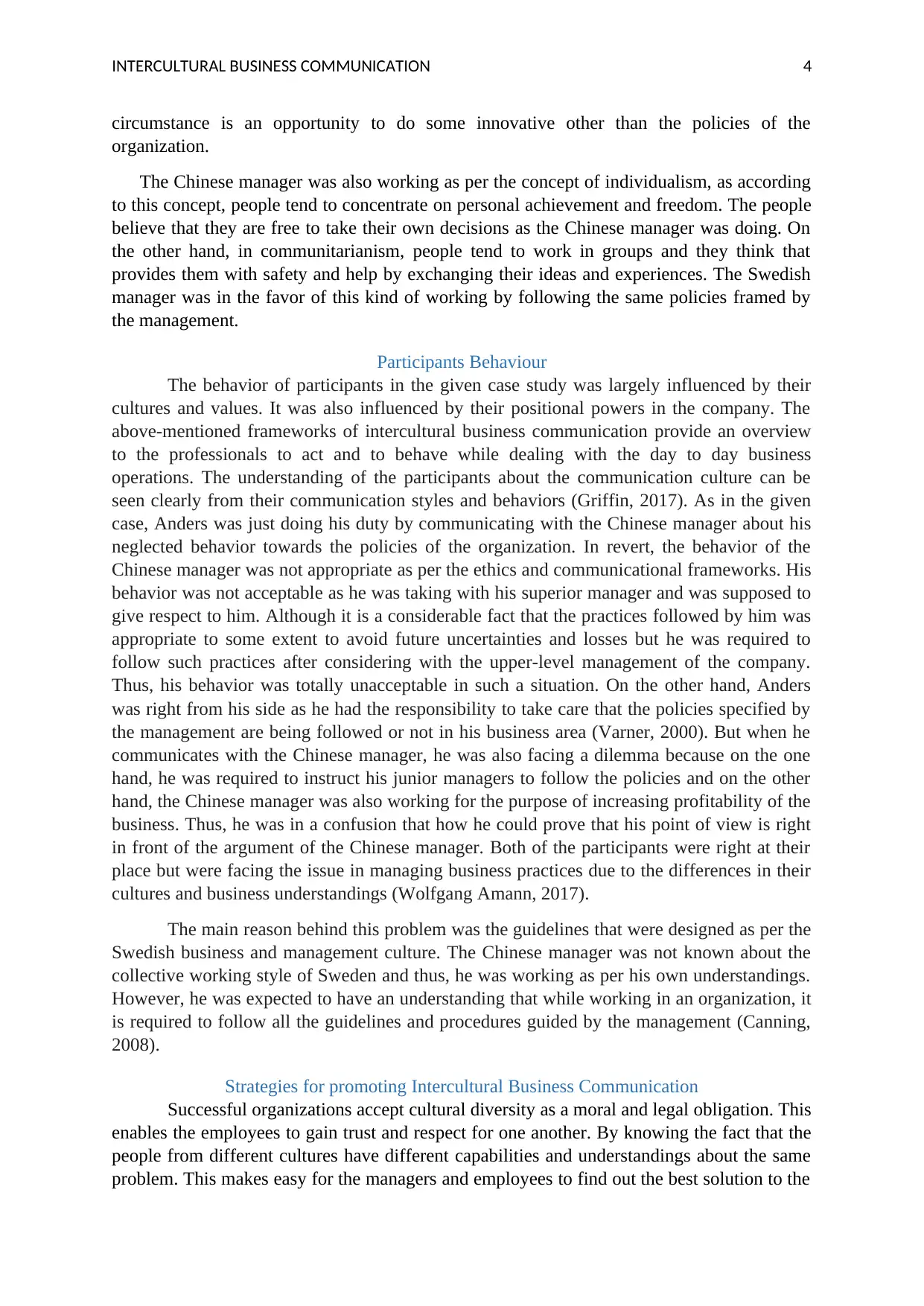
INTERCULTURAL BUSINESS COMMUNICATION 4
circumstance is an opportunity to do some innovative other than the policies of the
organization.
The Chinese manager was also working as per the concept of individualism, as according
to this concept, people tend to concentrate on personal achievement and freedom. The people
believe that they are free to take their own decisions as the Chinese manager was doing. On
the other hand, in communitarianism, people tend to work in groups and they think that
provides them with safety and help by exchanging their ideas and experiences. The Swedish
manager was in the favor of this kind of working by following the same policies framed by
the management.
Participants Behaviour
The behavior of participants in the given case study was largely influenced by their
cultures and values. It was also influenced by their positional powers in the company. The
above-mentioned frameworks of intercultural business communication provide an overview
to the professionals to act and to behave while dealing with the day to day business
operations. The understanding of the participants about the communication culture can be
seen clearly from their communication styles and behaviors (Griffin, 2017). As in the given
case, Anders was just doing his duty by communicating with the Chinese manager about his
neglected behavior towards the policies of the organization. In revert, the behavior of the
Chinese manager was not appropriate as per the ethics and communicational frameworks. His
behavior was not acceptable as he was taking with his superior manager and was supposed to
give respect to him. Although it is a considerable fact that the practices followed by him was
appropriate to some extent to avoid future uncertainties and losses but he was required to
follow such practices after considering with the upper-level management of the company.
Thus, his behavior was totally unacceptable in such a situation. On the other hand, Anders
was right from his side as he had the responsibility to take care that the policies specified by
the management are being followed or not in his business area (Varner, 2000). But when he
communicates with the Chinese manager, he was also facing a dilemma because on the one
hand, he was required to instruct his junior managers to follow the policies and on the other
hand, the Chinese manager was also working for the purpose of increasing profitability of the
business. Thus, he was in a confusion that how he could prove that his point of view is right
in front of the argument of the Chinese manager. Both of the participants were right at their
place but were facing the issue in managing business practices due to the differences in their
cultures and business understandings (Wolfgang Amann, 2017).
The main reason behind this problem was the guidelines that were designed as per the
Swedish business and management culture. The Chinese manager was not known about the
collective working style of Sweden and thus, he was working as per his own understandings.
However, he was expected to have an understanding that while working in an organization, it
is required to follow all the guidelines and procedures guided by the management (Canning,
2008).
Strategies for promoting Intercultural Business Communication
Successful organizations accept cultural diversity as a moral and legal obligation. This
enables the employees to gain trust and respect for one another. By knowing the fact that the
people from different cultures have different capabilities and understandings about the same
problem. This makes easy for the managers and employees to find out the best solution to the
circumstance is an opportunity to do some innovative other than the policies of the
organization.
The Chinese manager was also working as per the concept of individualism, as according
to this concept, people tend to concentrate on personal achievement and freedom. The people
believe that they are free to take their own decisions as the Chinese manager was doing. On
the other hand, in communitarianism, people tend to work in groups and they think that
provides them with safety and help by exchanging their ideas and experiences. The Swedish
manager was in the favor of this kind of working by following the same policies framed by
the management.
Participants Behaviour
The behavior of participants in the given case study was largely influenced by their
cultures and values. It was also influenced by their positional powers in the company. The
above-mentioned frameworks of intercultural business communication provide an overview
to the professionals to act and to behave while dealing with the day to day business
operations. The understanding of the participants about the communication culture can be
seen clearly from their communication styles and behaviors (Griffin, 2017). As in the given
case, Anders was just doing his duty by communicating with the Chinese manager about his
neglected behavior towards the policies of the organization. In revert, the behavior of the
Chinese manager was not appropriate as per the ethics and communicational frameworks. His
behavior was not acceptable as he was taking with his superior manager and was supposed to
give respect to him. Although it is a considerable fact that the practices followed by him was
appropriate to some extent to avoid future uncertainties and losses but he was required to
follow such practices after considering with the upper-level management of the company.
Thus, his behavior was totally unacceptable in such a situation. On the other hand, Anders
was right from his side as he had the responsibility to take care that the policies specified by
the management are being followed or not in his business area (Varner, 2000). But when he
communicates with the Chinese manager, he was also facing a dilemma because on the one
hand, he was required to instruct his junior managers to follow the policies and on the other
hand, the Chinese manager was also working for the purpose of increasing profitability of the
business. Thus, he was in a confusion that how he could prove that his point of view is right
in front of the argument of the Chinese manager. Both of the participants were right at their
place but were facing the issue in managing business practices due to the differences in their
cultures and business understandings (Wolfgang Amann, 2017).
The main reason behind this problem was the guidelines that were designed as per the
Swedish business and management culture. The Chinese manager was not known about the
collective working style of Sweden and thus, he was working as per his own understandings.
However, he was expected to have an understanding that while working in an organization, it
is required to follow all the guidelines and procedures guided by the management (Canning,
2008).
Strategies for promoting Intercultural Business Communication
Successful organizations accept cultural diversity as a moral and legal obligation. This
enables the employees to gain trust and respect for one another. By knowing the fact that the
people from different cultures have different capabilities and understandings about the same
problem. This makes easy for the managers and employees to find out the best solution to the
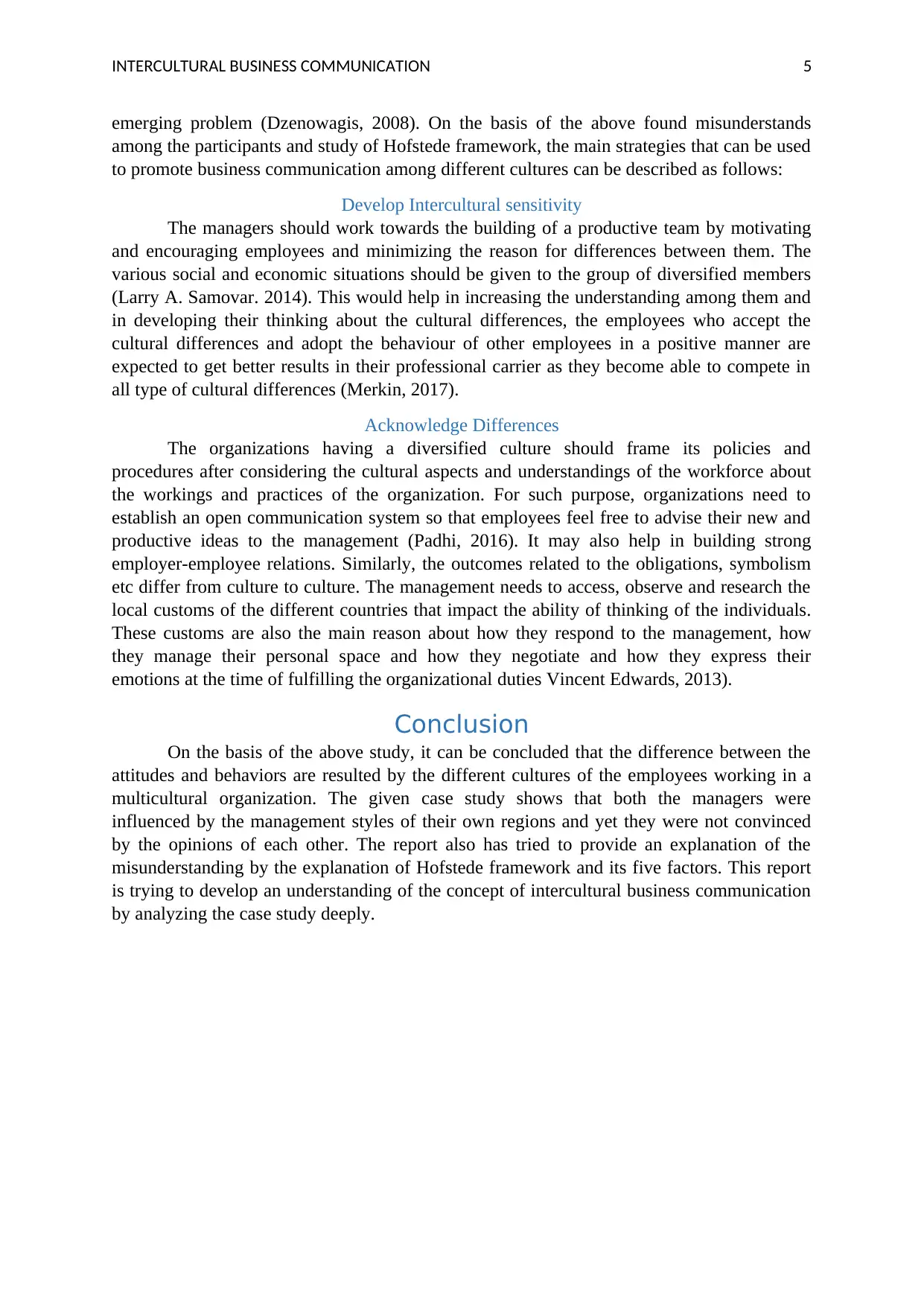
INTERCULTURAL BUSINESS COMMUNICATION 5
emerging problem (Dzenowagis, 2008). On the basis of the above found misunderstands
among the participants and study of Hofstede framework, the main strategies that can be used
to promote business communication among different cultures can be described as follows:
Develop Intercultural sensitivity
The managers should work towards the building of a productive team by motivating
and encouraging employees and minimizing the reason for differences between them. The
various social and economic situations should be given to the group of diversified members
(Larry A. Samovar. 2014). This would help in increasing the understanding among them and
in developing their thinking about the cultural differences, the employees who accept the
cultural differences and adopt the behaviour of other employees in a positive manner are
expected to get better results in their professional carrier as they become able to compete in
all type of cultural differences (Merkin, 2017).
Acknowledge Differences
The organizations having a diversified culture should frame its policies and
procedures after considering the cultural aspects and understandings of the workforce about
the workings and practices of the organization. For such purpose, organizations need to
establish an open communication system so that employees feel free to advise their new and
productive ideas to the management (Padhi, 2016). It may also help in building strong
employer-employee relations. Similarly, the outcomes related to the obligations, symbolism
etc differ from culture to culture. The management needs to access, observe and research the
local customs of the different countries that impact the ability of thinking of the individuals.
These customs are also the main reason about how they respond to the management, how
they manage their personal space and how they negotiate and how they express their
emotions at the time of fulfilling the organizational duties Vincent Edwards, 2013).
Conclusion
On the basis of the above study, it can be concluded that the difference between the
attitudes and behaviors are resulted by the different cultures of the employees working in a
multicultural organization. The given case study shows that both the managers were
influenced by the management styles of their own regions and yet they were not convinced
by the opinions of each other. The report also has tried to provide an explanation of the
misunderstanding by the explanation of Hofstede framework and its five factors. This report
is trying to develop an understanding of the concept of intercultural business communication
by analyzing the case study deeply.
emerging problem (Dzenowagis, 2008). On the basis of the above found misunderstands
among the participants and study of Hofstede framework, the main strategies that can be used
to promote business communication among different cultures can be described as follows:
Develop Intercultural sensitivity
The managers should work towards the building of a productive team by motivating
and encouraging employees and minimizing the reason for differences between them. The
various social and economic situations should be given to the group of diversified members
(Larry A. Samovar. 2014). This would help in increasing the understanding among them and
in developing their thinking about the cultural differences, the employees who accept the
cultural differences and adopt the behaviour of other employees in a positive manner are
expected to get better results in their professional carrier as they become able to compete in
all type of cultural differences (Merkin, 2017).
Acknowledge Differences
The organizations having a diversified culture should frame its policies and
procedures after considering the cultural aspects and understandings of the workforce about
the workings and practices of the organization. For such purpose, organizations need to
establish an open communication system so that employees feel free to advise their new and
productive ideas to the management (Padhi, 2016). It may also help in building strong
employer-employee relations. Similarly, the outcomes related to the obligations, symbolism
etc differ from culture to culture. The management needs to access, observe and research the
local customs of the different countries that impact the ability of thinking of the individuals.
These customs are also the main reason about how they respond to the management, how
they manage their personal space and how they negotiate and how they express their
emotions at the time of fulfilling the organizational duties Vincent Edwards, 2013).
Conclusion
On the basis of the above study, it can be concluded that the difference between the
attitudes and behaviors are resulted by the different cultures of the employees working in a
multicultural organization. The given case study shows that both the managers were
influenced by the management styles of their own regions and yet they were not convinced
by the opinions of each other. The report also has tried to provide an explanation of the
misunderstanding by the explanation of Hofstede framework and its five factors. This report
is trying to develop an understanding of the concept of intercultural business communication
by analyzing the case study deeply.
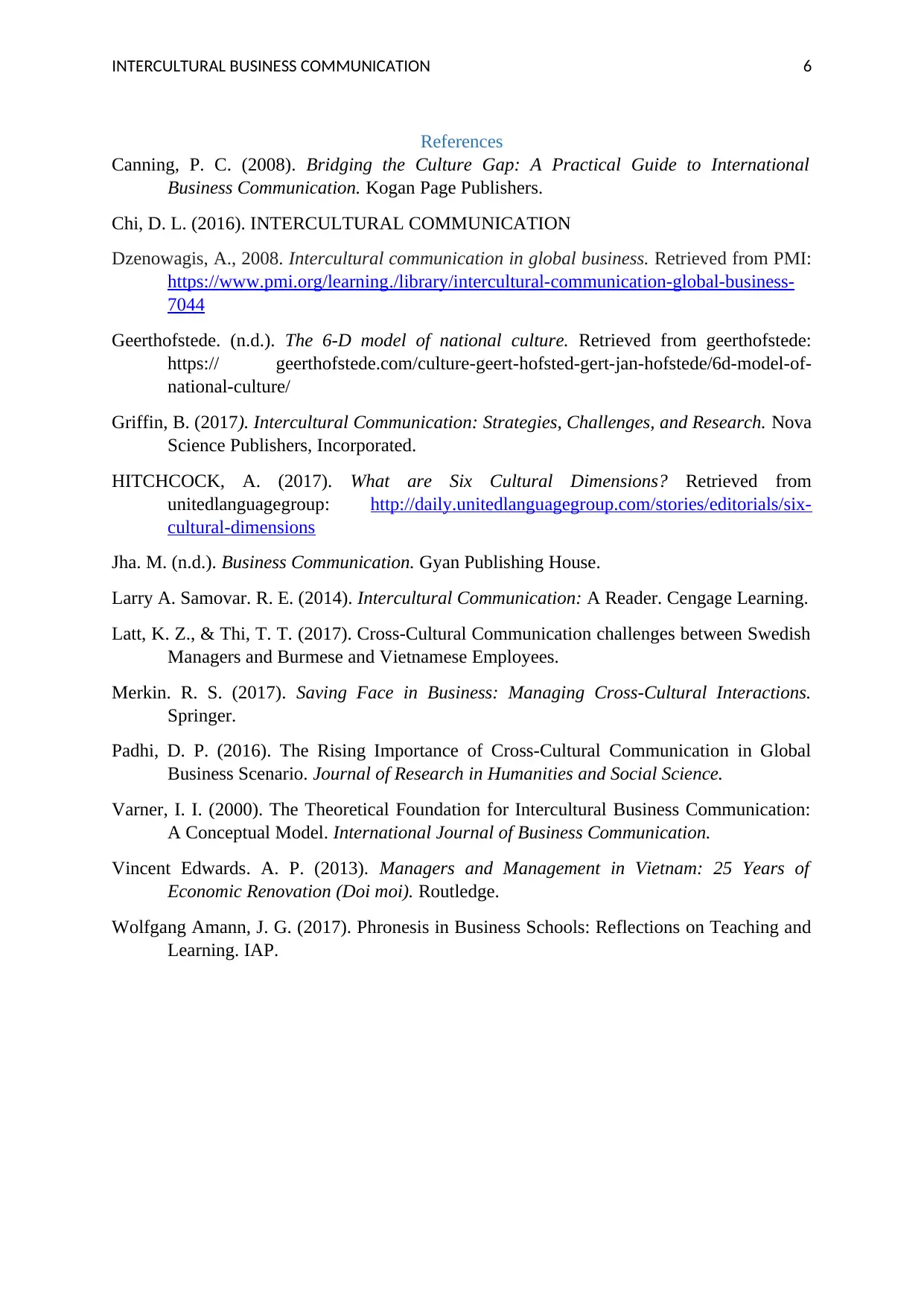
INTERCULTURAL BUSINESS COMMUNICATION 6
References
Canning, P. C. (2008). Bridging the Culture Gap: A Practical Guide to International
Business Communication. Kogan Page Publishers.
Chi, D. L. (2016). INTERCULTURAL COMMUNICATION
Dzenowagis, A., 2008. Intercultural communication in global business. Retrieved from PMI:
https://www.pmi.org/learning./library/intercultural-communication-global-business-
7044
Geerthofstede. (n.d.). The 6-D model of national culture. Retrieved from geerthofstede:
https:// geerthofstede.com/culture-geert-hofsted-gert-jan-hofstede/6d-model-of-
national-culture/
Griffin, B. (2017). Intercultural Communication: Strategies, Challenges, and Research. Nova
Science Publishers, Incorporated.
HITCHCOCK, A. (2017). What are Six Cultural Dimensions? Retrieved from
unitedlanguagegroup: http://daily.unitedlanguagegroup.com/stories/editorials/six-
cultural-dimensions
Jha. M. (n.d.). Business Communication. Gyan Publishing House.
Larry A. Samovar. R. E. (2014). Intercultural Communication: A Reader. Cengage Learning.
Latt, K. Z., & Thi, T. T. (2017). Cross-Cultural Communication challenges between Swedish
Managers and Burmese and Vietnamese Employees.
Merkin. R. S. (2017). Saving Face in Business: Managing Cross-Cultural Interactions.
Springer.
Padhi, D. P. (2016). The Rising Importance of Cross-Cultural Communication in Global
Business Scenario. Journal of Research in Humanities and Social Science.
Varner, I. I. (2000). The Theoretical Foundation for Intercultural Business Communication:
A Conceptual Model. International Journal of Business Communication.
Vincent Edwards. A. P. (2013). Managers and Management in Vietnam: 25 Years of
Economic Renovation (Doi moi). Routledge.
Wolfgang Amann, J. G. (2017). Phronesis in Business Schools: Reflections on Teaching and
Learning. IAP.
References
Canning, P. C. (2008). Bridging the Culture Gap: A Practical Guide to International
Business Communication. Kogan Page Publishers.
Chi, D. L. (2016). INTERCULTURAL COMMUNICATION
Dzenowagis, A., 2008. Intercultural communication in global business. Retrieved from PMI:
https://www.pmi.org/learning./library/intercultural-communication-global-business-
7044
Geerthofstede. (n.d.). The 6-D model of national culture. Retrieved from geerthofstede:
https:// geerthofstede.com/culture-geert-hofsted-gert-jan-hofstede/6d-model-of-
national-culture/
Griffin, B. (2017). Intercultural Communication: Strategies, Challenges, and Research. Nova
Science Publishers, Incorporated.
HITCHCOCK, A. (2017). What are Six Cultural Dimensions? Retrieved from
unitedlanguagegroup: http://daily.unitedlanguagegroup.com/stories/editorials/six-
cultural-dimensions
Jha. M. (n.d.). Business Communication. Gyan Publishing House.
Larry A. Samovar. R. E. (2014). Intercultural Communication: A Reader. Cengage Learning.
Latt, K. Z., & Thi, T. T. (2017). Cross-Cultural Communication challenges between Swedish
Managers and Burmese and Vietnamese Employees.
Merkin. R. S. (2017). Saving Face in Business: Managing Cross-Cultural Interactions.
Springer.
Padhi, D. P. (2016). The Rising Importance of Cross-Cultural Communication in Global
Business Scenario. Journal of Research in Humanities and Social Science.
Varner, I. I. (2000). The Theoretical Foundation for Intercultural Business Communication:
A Conceptual Model. International Journal of Business Communication.
Vincent Edwards. A. P. (2013). Managers and Management in Vietnam: 25 Years of
Economic Renovation (Doi moi). Routledge.
Wolfgang Amann, J. G. (2017). Phronesis in Business Schools: Reflections on Teaching and
Learning. IAP.
1 out of 7
Related Documents
Your All-in-One AI-Powered Toolkit for Academic Success.
+13062052269
info@desklib.com
Available 24*7 on WhatsApp / Email
![[object Object]](/_next/static/media/star-bottom.7253800d.svg)
Unlock your academic potential
© 2024 | Zucol Services PVT LTD | All rights reserved.





